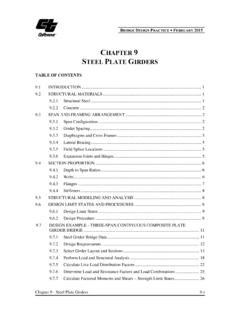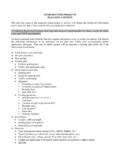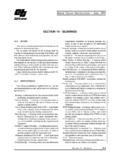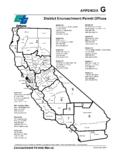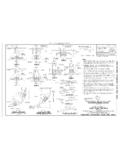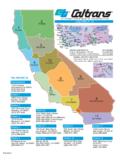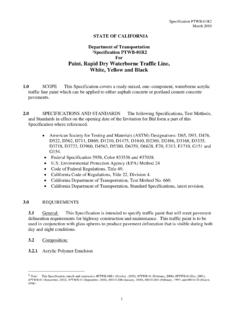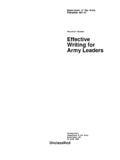Transcription of RANKING CHARACTER-DEFINING FEATURES - Caltrans
1 Exhibit : RANKING CHARACTER-DEFINING FEATURES Table of Contents RANKING Criteria .. 1. A. Craftsmanship .. 1. B. Conveying Significance .. 1. C. Public Benefit .. 1. D. Visibility and transparency .. 2. E. Integrity .. 2. Point Range (Optional) .. 2. Properties Within Historic Districts .. 2. Criteria Matrix .. 4. Examples .. 5. Individually eligible historic property .. 5. Individually eligible historic property .. 6. Eligible historic District .. 6. Eligible historic District .. 7. Contributing Property in Markham Place historic District .. 8. Contributing Property in Markham Place historic District .. 8. 2014 Update Page - i Volume 2 -Standard Environmental Reference Copyright 2014 California Department of Transportation.
2 All rights reserved. Exhibit : RANKING CHARACTER-DEFINING FEATURES Caltrans guidance regarding the assessment and RANKING of CHARACTER-DEFINING FEATURES (also called essential physical FEATURES or contributing elements) is based on the National Park Service publication, Preservation Brief 17: Architectural character - Identifying the Visual Aspects of Historic Buildings as an Aid to Preserving Their character , also a National Park Service publication. The guidance is also grounded in the guidance in National Register Bulletin 15. Contact the Built Environment Preservation Services Branch Chief in CSO for additional guidance, copies of CHARACTER-DEFINING feature forms and assistance.
3 When projects affect historic properties, oftentimes it is necessary to determine which FEATURES are most important to preserve in order avoid or minimize harm, to develop appropriate mitigation measures, or to determine whether proposed rehabilitation, preservation, maintenance and other activities are consistent with the Secretary of the Interior's Treatment of Historic Properties. To guide proposed actions or changes to historic properties Caltrans , in consultation with SHPO, developed a system of RANKING FEATURES based on a set of criteria. RANKING Criteria A. Craftsmanship High: high artistic value, craftsmanship, design, materials Medium: expected feature linked to contributing architectural style or method of construction Low: standard historic fabric (commonly found during period of significance).
4 B. Conveying Significance High: quintessential & Indispensable (without it the significance is lost). Medium: Important (without it significance is diminished). Low: Little effect but adverse effects could be cumulative C. Public Benefit High: public has the opportunity to use or enjoy with little or no effort (outdoor public space, feature or access, public building, etc.). Medium: public has the opportunity to use or enjoy but with some effort (semi- public outdoor space, building or feature with occasional access). 2014 Update Page - 1. Volume 2 -Standard Environmental Reference Copyright 2014 California Department of Transportation. All rights reserved. Exhibit : RANKING CHARACTER-DEFINING FEATURES Low: public has little or no opportunity to use or enjoy or (mostly private spaces).
5 D. Visibility and transparency High: Primary, salient feature ( , something you can see from the street or public space). Medium: Secondary, somewhat obscured ( , something you can see through doors and windows). Low: Tertiary/obscured ( , private space that isn't visible). E. Integrity High: Intact as designed/original Medium: Somewhat altered but still conveys significance Low: Substantially altered; no longer conveys significance Point Range (Optional). Assigning points to achieve a RANKING usually is not necessary; however, there may be times when it is useful, such as when certain FEATURES may be borderline. Caltrans developed a point system that may be useful in these instances, but its use is discretionary.
6 Points in each of the above RANKING criteria would be high equals 5 points, medium equals 2 points, and low equals 1 point. Total points for the combined RANKING criteria are high equals 15 points, medium equals 10 points and low . equals 5 points. Total combined points for RANKING CHARACTER-DEFINING FEATURES 13-15 points: Most Significant (strongly conveys sense of time and place). 9-12 points: Significant (conveys sense and place). 5-8 points: Less significant (still conveys sense of time and place, but to a lesser degree). Less than 5 points: Historic fabric, not CHARACTER-DEFINING feature Properties Within Historic Districts Before CHARACTER-DEFINING FEATURES can be identified and ranked for contributing properties within a historic district, it is first necessary to identify the character - defining FEATURES of the district itself because the district CHARACTER-DEFINING FEATURES serve as the framework for the contributing properties.
7 2014 Update Page - 2. Volume 2 -Standard Environmental Reference Copyright 2014 California Department of Transportation. All rights reserved. Exhibit : RANKING CHARACTER-DEFINING FEATURES When determining the CHARACTER-DEFINING FEATURES for affected contributing building or structures, first look at the setting and environment for district FEATURES and note which environmental and landscape FEATURES are linked to the district (including spatial relationships, landscaping or vegetation, access points). Then look at all sides of the building or structure, noting its CHARACTER-DEFINING FEATURES . In most cases these FEATURES would be linked to the type, style or construction of the building or structure.
8 Rear exteriors rarely are visible from the street or public access, nor do they have public benefit, so are rarely called out as CHARACTER-DEFINING FEATURES . If the rear of contributing buildings or structures are visible by public, for instance from streets, alleys, or public walkways, the rear sides may contain CHARACTER-DEFINING FEATURES . Look at interior of the contributing buildings or structures for FEATURES that may be visible from the street or sidewalk and that would convey district significance. Interior spaces other than primary rooms generally will not convey district significance or appearance. Individually eligible buildings or structures that are also district contributors might have more interior CHARACTER-DEFINING FEATURES .
9 Within historic district, the CHARACTER-DEFINING FEATURES for contributing properties are linked to the CHARACTER-DEFINING FEATURES of the district. Often the FEATURES for the contributing property will rank higher for that specific property than they do for the district overall. The contributing property's CHARACTER-DEFINING FEATURES are specific to that particular property and how it conveys the district's significance. So, the relative RANKING . Most significant, Significant and Less Significant doesn't always match up to the district's CDF significance. Example: Side driveways & detached garages may be significant FEATURES in a historic district, but one of the most significant FEATURES in conveying how that particular house contributes to the district.
10 2014 Update Page - 3. Volume 2 -Standard Environmental Reference Copyright 2014 California Department of Transportation. All rights reserved. Exhibit : RANKING CHARACTER-DEFINING FEATURES Criteria Matrix Below is the set of criteria for RANKING CHARACTER-DEFINING FEATURES in matrix form. It was used to identify and rank the FEATURES in the examples that follow. CRITERIA MATRIX FOR RANKING character defining FEATURES *. HIGH = 3 POINTS MEDIUM = 2 POINTS LOW = 1 POINT. Expected feature linked to High artistic value, Standard historic fabric A. contributing architectural craftsmanship, (commonly found during Craftsmanship style or method of design, materials period of significance).

